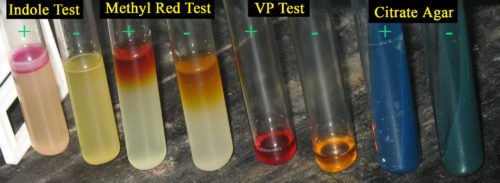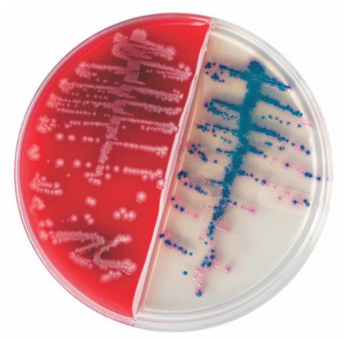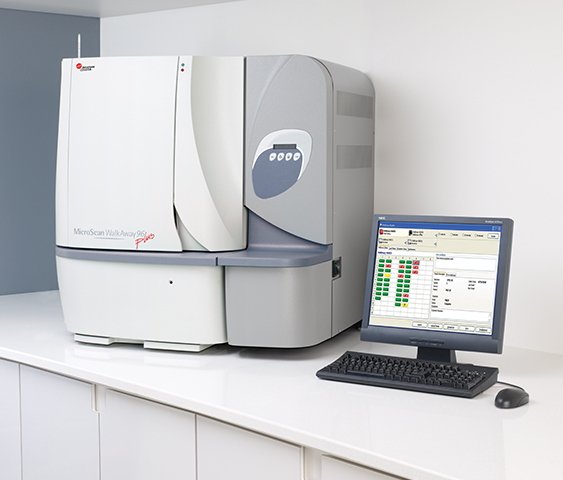The Tools of the Trade: Chrome Agar
When I was in school going through my microbiology courses, it was hectic. Don't get me wrong, I loved those classes and my desire to do well was genuine. I remember setting up biochemical tests to identify organisms. I recall learning about different chemicals and memorizing the reaction patterns. Those classes taught me the old (I mean old) school way of testing.

The classic set of reactions. There are dozens more depending on what you are testing.
I can't imagine where people got the idea of scientists having colored fluids from. /s
While playing with different colored tubes was fun, it was time consuming. Not to mention, the quantity of isolated bacteria needed to inoculate them. Then, the nightmare of keeping them organized and managing space ensued. Can you imagine doing that for the sheer number of patients a hospital encounters?
Lucky for us, the industry is far more advanced than that. I learned that firsthand when I visited a clinical laboratory.
One of the most useful tools for a microbiology lab are the BD BBL™ CHROMagar™ Orientation and TSA II I-Plate™. That's a mouthful, but we call it chrome agar for short. They are very useful for working through patient urine cultures.

It's a product photo you see.
The CHROM side of the agar provides a color indicator of presumptive identifications. The sheep blood side helps with colony types, morphology, and hemolysis. They complement each other. In terms of urine cultures, they also help determine if the specimen was a clean catch. In most urinary infections, there shouldn't be more than 1 or 2 organisms observed. The laboratory often dismiss cultures with 3 or more organisms as questionable. Although, clinicians are welcome to insist further testing.
In the stock image above, one could tell there are two different bacteria growing in the culture. They are most likely E. coli (pink) and a species of Enterococcus (blue). It's not uncommon for laboratory scientists to misread young blue colonies. This is where the blood side helps differentiate based on morphology.
You see how much easier that is when comparing to old school methods?
Then what?
As of now, the lab I work at uses the MicroScan WalkAway-96 Plus to process the high volume of cultures. That machine itself would take pages to explain, and we have five of them. The gist of it is that it does the biochemical, as well as the susceptibility, tests. The lab would evaluate the test results and then finalize them on the reports to clinicians.

It's a beast and a chemical and water hog.
The clinicians can then treat their patients based on the data or request more testing as needed.
The tools of the trade help streamline an otherwise time-consuming and daunting process. In fact, there's a whole family of chrome agar that simplify testing altogether. Here's a pdf of some of the cool selective agar that I get to play with at work:
At least, the colors are pretty to look at. We have a saying in the lab that the cool stuff you see are usually the worst for the patients. I never cease to feel conflicted about seeing interesting test results. This is because I'm also reminded that the patients are most likely not having a good time.
Anyways, a quick summary involving the tools and processes mentioned above.
The Process
- Sample taken. Clinicians order tests and sent to lab.
- Go through lab processing. Cultures set up.
- Cultures read. Decide if cultures require tests. If not, skip to 6. If no growth, wait for another 18-24 hours.
- Results evaluated. Determine if they need more tests.
- Results finalized and sent to clinicians.
- The end. Unless clinicians want more tests or have questions.
The average turnaround time for urine cultures is between 35-42 hours. That's according to the last stat report I've seen from my supervisor. More complex cases could take longer. The lab goes through hundreds of them a day.
To listen to the audio version of this article click on the play image.

Brought to you by @tts. If you find it useful please consider upvoting this reply.
According to the Bible, What is the proper way of teaching children about the Church??
Comment what you understand of our Youtube Video to receive our full votes. We have 30,000 #SteemPower. It's our little way to Thank you, our beloved friend.
Check our Discord Chat
Follow my Steemit account on https://www.steemit.com/@hiroyamagishi
I love Chemistry as well and medicine. The last decade alone has just kept exponentially evolved which is needed. I make tinctures and such and enjoy reading posts like this where I actually learn something.
axey
Hey! Thanks for stopping by.
Yeah, things have changed a lot since I started working in microbiology back in 2014. But luckily, the principles I learned haven't changed.
You do quite an interesting job!
I really loved my chemistry and science classes (and their labs) back in high school. But not as much as computers =]
Computers are very much tied to them these days on the job.
But, that doesn’t stop you from enjoying the subjects itself.
Questo post è stato condiviso e votato all'interno del discord del team curatori di discovery-it.
This post was shared and voted inside the discord by the curators team of discovery-it
So at my urologist last week I walked in at 9:15 pissed in a cup and at 9:45 they told me no infection and I was on my way. They probably just look at that agar then huh? I was wondering how they did it so fast right in the office like that. Very cool info. I took one microbio class (conservation biology major) and don’t really remember anything from it. I had a really hard botany class that semester and I was more on the microscope in there than in the microbio class.
There’s a chance your urologist used results from urinalysis, which is done by the chemistry/haematology department.
Your doctor might have felt it was not necessary to order a culture.
One thing I did not include in this post is that we do refer back to other departments’ results to decide if what we see on the plates are real, contaminants, or potential clerics errors.
too drunk, didnt read. hears a jerky
In the past, we did not have the luxury to purchase ready made agar, buffer and etc... Neither did we have the luxury of a technician or cleaner. Everything had to be prepared from scratch.
When I had symptom similar to UTI, the clinician suggested that I took a urine test. After a long time struggling to find the cause, turned out that I was sensitive to NSAID. Whenever a medical professional prescribed NSAID, they need to include proton pump inhibitor. This incident caused me so much agony.
Sorry that happened to ya.
At least, they did figure it out.